A Penguin Angle on the Ox: Day One at Macworld
Yesterday morning while I was headed across the Howard Street in San Francisco, on my way to the Media queue lined up for Steve Jobs' much-hyped keynote address at Macworld, the first guy I ran into was Chris DiBona, wearing his Slashdot badge. Joining him were several other semi-familiar looking guys, so for a moment I actually thought I was at a LinuxWorld Expo. But this was the first day of Macworld Expo--same world, same venue (Moscone Center), different show.
Given the changes in both markets, however, a little confusion is understandable. The constituencies have begun to overlap. The foundation under Apple's OS X is BSD. Politics and rivalries aside, this attracts a lot of Linux weenies, not to mention UNIX heavies of varied provenance, including BSD guru Jordan Hubbard, who now works for Apple on the Darwin Project.
I wasn't inside more than a minute before a friend asked me if I had heard about Moxi, the Palo Alto company founded by Steve Perlman, a veteran of Apple and WebTV. Moxi had just made news by going public with a sexy new media center that promised to blow lots of current consumer electronics hardware out of the water. Moxi poses a variety of threats to TiVo, Sony and other entertaining companies. But none of those topics were the subjects at hand. Instead my friend said this: "Did you hear it runs on Linux?"
In past years at Macworld my Linux Journal shirt would have seemed more out of place than a leisure suit. But this year it fits right in. There were people in line wearing Sun and SGI schwag too. One guy told me he thought OS X was "subversive" because it "seeds" millions of otherwise unsuspecting households with open-source UNIX. "I can go to my Mom's, fire up her iMac, open a shell, ssh to my own server and get some real work done", one guy said to me. Ahead in line a kid parked an iBook on a recycling bin, turning it this way and that, looking for an 802.11b signal. On one corner of the laptop's lid was a little blue "Linux Inside" sticker.
Of course there was plenty of buzz about what Steve would announce at the show. This is beyond predictable, since Steve's keynote speech is high mass on the holiest day in the Macintosh liturgical calendar. The difference this year was an unusually high level of hype. "Prepare to be blown away", the Apple web site teased. But thanks to a screw-up by Time Canada, the upcoming Time magazine cover story about Apple's radically odd new iMac was already all over the Web, so speculation ran to lesser matters. What else would he talk about?
The answer was: not much.
Last year Steve had a lot to say about the UNIX roots of OS X, about open source and about the debt of influence Apple owed to thousands of customers and outside hackers who contributed code to the kernel. I looked forward to a progress report, but this year he just talked about numbers. There are 2,500 new applications for OS X, for example. Later I heard that a lot of these were ported UNIX apps, which was the kind of thing I wanted to know more about.
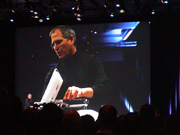
Then he went on to review the company's "digital hub" strategy (your PC as a device driver for all kinds of consumer electronics peripherals) and introduced a few new SKUs in the existing iBook line. Somewhere in there he introduced Apple's attractive new iPhoto software, which makes organizing, printing and sharing photographs extremely simple and easy (as well as free-as-in-beer).
But the Big Deal was the new iMac. "This is the best thing we've ever done", Steve said, as if there was nothing more to say. It was beautiful, with a form factor that had more in common with a Luxo lamp or a makeup mirror than with anything you might call a computer. Apple engineers had worked on it for two and a half years. He showed it tenderly to the audience, as if he just showed up with his new girlfriend. It would be bad form to upstage her.
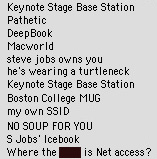
So there wasn't even Steve's usual "one more thing" encore. That was how he had introduced the company's then-new Titanium laptop one year ago.
The entire service was over two hours long (about average), so wireless-equipped audience members had fun setting up adhoc network identities while they tried to find a WiFi base station with access to the Net. (On the right there's a screen shot of my own view.)
There wasn't any, which is consistent with Apple's highly managed approach to PR flow.
Anyway, the real interesting stuff happened afterwards, downstairs on the trade show floor, in a massive private booth Apple had set up just for The Media. I was eager to see what was up with OS X, especially around Darwin, its BSD-based open-source kernel. Was there a Penguin/Ox synergy going on? If so, what was that about, and where was it headed?
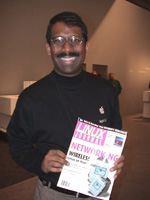
On the walk to the booth I ran into Tony Fadell, a guy I've known for a few years but hadn't seen in awhile. (That's him on the right, below.) He was wearing an Apple badge. "What do you do for Apple?" I asked. "I designed the iPod", he replied.
Then I ran into Ernest Prabhakar (left, with a copy of Linux Journal) who leads product marketing for Darwin. He was very eager to talk about synergies, not just between two operating systems and the various cultures involved, but between different development interests and modalities. For example, he said AppleScript Studio has the same relationship to GUI development as shell to command line. "Think about pipelining, but in three dimensions." He was way past me, but I dug his enthusiasm.
Then he pointed me toward Brian Croll, who used to run Eazel. I had interviewed Brian last spring, a few weeks before that company went under. Before Eazel, Brian had been with Sun for many years. Now he was running engineering for the Darwin end of OS X. And he was excited about it--especially about the level of open-source activity that's going on with Darwin.
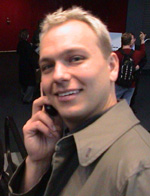
What impressed me was the "and" logic going on. These guys don't see OS X as a Linux competitor. "The more you know about Linux the better you can understand what's happening at the foundation of OS X," one guy told me. "OS X is a desktop UNIX that drives a lot of devices. It likes Linux servers, and it likes Linux devices. It even likes Linux desktops. Vice versa too. There isn't a problem here."
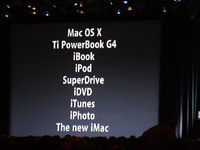
One commercial software guy had another interesting thing to say: "Apple doesn't have absolute control of its developer community, and it's not trying to take over the world. As a Microsoft developer, you've got this huge gravitational field to contend with, plus the fact that they want to lock everybody in. This creates a much different mood."
There's another difference. Microsoft often talks about its "right to innovate." Even if we grant that Microsoft does innovate on some things, its reputation is quite otherwise. Not so with Apple. When Steve Jobs listed nine Apple "innovations" over the last year (the slide on the left), it's hard not to grant the company a high degree of originality, even if one protests the company's proprietary tendencies.
In an elevator somebody asked me why the Linux Journal logo on my shirt didn't have a penguin. I turned the question around and asked why OS X didn't have a mascot. "OS X needs an animal," I said.
"What would it be?" somebody asked.
"How about an ox?" I suggested.
"Ooo," one guy said. "Apple would never go for that."
"Why should that matter?"
"It's BSD. Why not a red devil?"
"Because it's not BSD. Darwin is only 'based' on BSD."
"Then how about a red devil with a big beard, like Charles Darwin?"
"Or maddog."
"I think you should go back to the ox."
Tomorrow I'm off to find out more about what's really up with Darwin. The Apple PR apparatus is mostly geared to showcase the company's prettiest offerings. Meanwhile, Darwin isn't an offering. It's more like an activity. For that I'll have to go straight to the geeks. It isn't hard. Some of them look pretty familiar.
Doc Searls is Senior Editor at Linux Journal.
email: doc@ssc.com






